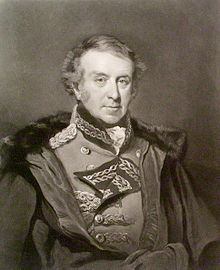

Sir Hew Dalrymple
| |
|---|---|

Sir Hew Dalrymple, 1st Baronet, by John Jackson, 1831
| |
| Born | 3 December 1750 Ayr, Scotland |
| Died | 9 April 1830 (aged 79) London, England |
| Buried | |
| Allegiance | |
| Service/ | |
| Rank | General |
| Commands held | Northern District |
| Battles/wars | Peninsular War |
General Sir Hew Whitefoord Dalrymple, 1st Baronet (3 December 1750 – 9 April 1830) was a Scottish general in the British Army and Governor of Gibraltar.
Dalrymple was the only son of Captain John Dalrymple, of the 6th Dragoons and his second wife, Mary, née Ross (c.1719–1793).[1] Following his father's death in 1753, Dalrymple's mother married Sir James Adolphus Oughton.[1]
Dalrymple was commissioned as an ensign into the 31st Regiment of Foot in 1763,[2] was promoted lieutenant in 1766 and captain in 1768. He took time out from the Army to study at the University of Edinburgh from 1767 to 1768.[2] Dalrymple was knighted in 1779 thanks to the influence of his family.
Lieutenant-colonel of the 68th Foot in 1781, he was promoted to colonel when he transferred to the 1st Foot Guards. In 1793 he commanded a composite battalion of grenadiers in Lake's brigade under York in the Flanders Campaign, and saw action at Raismes 8 May, Famars 23 May, the Siege of Valenciennes 13 June – 28 July, and the Siege of Dunkirk 25 August – 10 September. He returned to Britain early in 1794 and was made major-general on 3 October.
In 1796, he was appointed Lieutenant Governor of Guernsey.[2] He became colonel of the 81st Regiment of Foot (Loyal Lincoln Volunteers) in 1797, transferred to the 37th (North Hampshire) Regiment of Foot in 1798 and to the Green Howards in 1810.
On 1 January 1801 he was promoted lieutenant-general and from 1802 to 1806 was general officer commanding Northern District.[2] In 1806, he was posted to Gibraltar to serve under Lt-General Fox. After Fox's departure he was made acting governor of Gibraltar, replacing Gordon Drummond, November 1806 – August 1808.
In 1808, he was appointed commander of the Portuguese Expedition, landing on 22 August after Junot's defeat at Vimiero to replace Wellesley and Burrard. He immediately halted Wellesley's pursuit of the beaten French to Lisbon. Lacking either confidence or intelligence, or both, on 31 August Dalrymple signed a truce with Junot allowing him to return to France in British ships with all his weapons, men and loot.[2]
This infamous truce, known as the Convention of Cintra,[3] was denounced both in London and in Portugal.[2] Dalrymple sailed for home to face an enquiry 4 October, and never held a field command again.
Sir John Moore, Dalrymple's replacement in Portugal, said he "was never able to determine on any point whatever".[4] "Sir Hew, having never had the experience of command, seems quite at a loss how to work with the different heads of department; the troops suffer".[5]
Made Colonel of the 57th (West Middlesex) Regiment in 1811, he was promoted General on 1 January 1812 through seniority. He was also made Governor of Blackness Castle in 1818.[2]
In 1783 he married Frances, daughter of General Francis Leighton, and together they had three daughters and two sons.[2]
| Military offices | ||
|---|---|---|
| Preceded by | Lieutenant Governor of Guernsey 1796–1802 |
Succeeded by |
| Preceded by | GOC Northern District 1802–1806 |
Succeeded by |
| Preceded by | Governor of Gibraltar (acting) 1806–1808 |
Succeeded by |
| Preceded by | Colonel of the 81st Regiment of Foot 1797–1798 |
Succeeded by |
| Preceded by | Colonel of the 37th (North Hampshire) Regiment of Foot 1798–1810 |
Succeeded by |
| Preceded by | Colonel of the 19th (The 1st Yorkshire North Riding) Regiment of Foot 1810–1811 |
Succeeded by |
| Preceded by | Colonel of the 57th (West Middlesex) Regiment of Foot 1811–1830 |
Succeeded by |
| Preceded by | Governor of Blackness Castle 1818–1830 |
Succeeded by |
| Baronetage of the United Kingdom | ||
| New creation | Baronet (of High Mark) 1815–1830 |
Succeeded by |